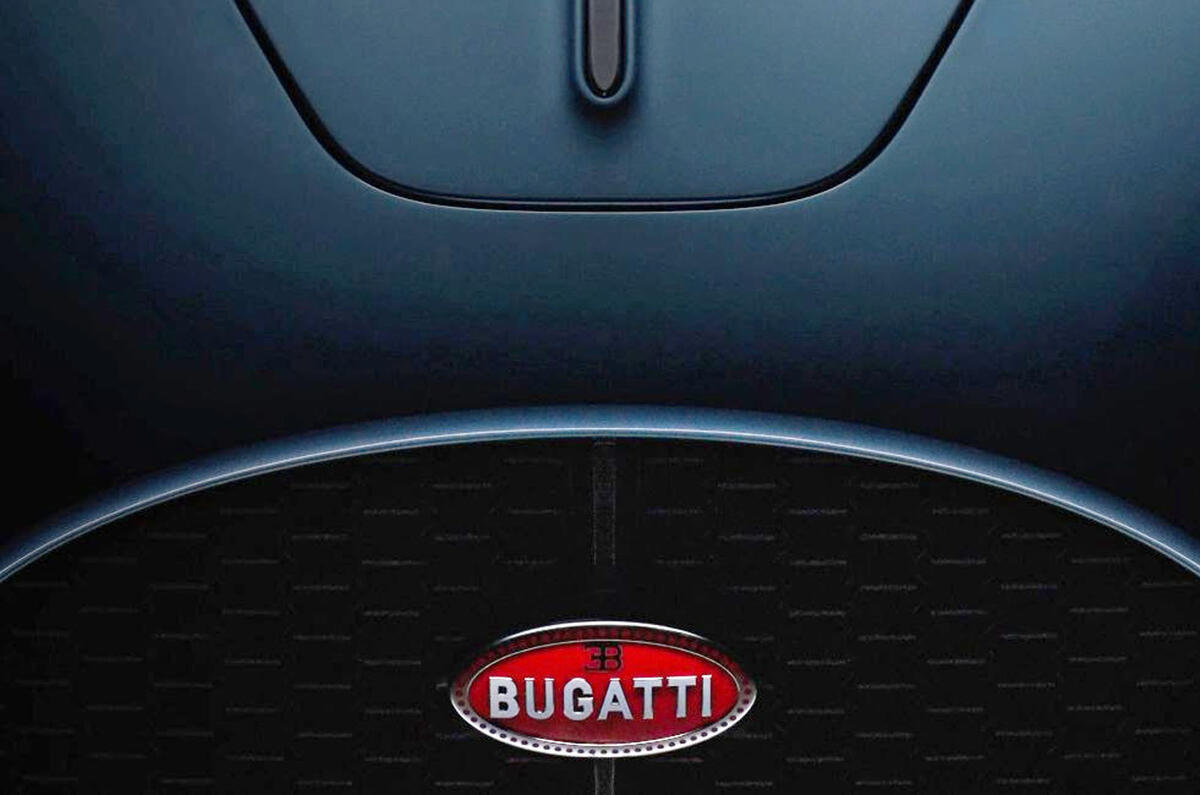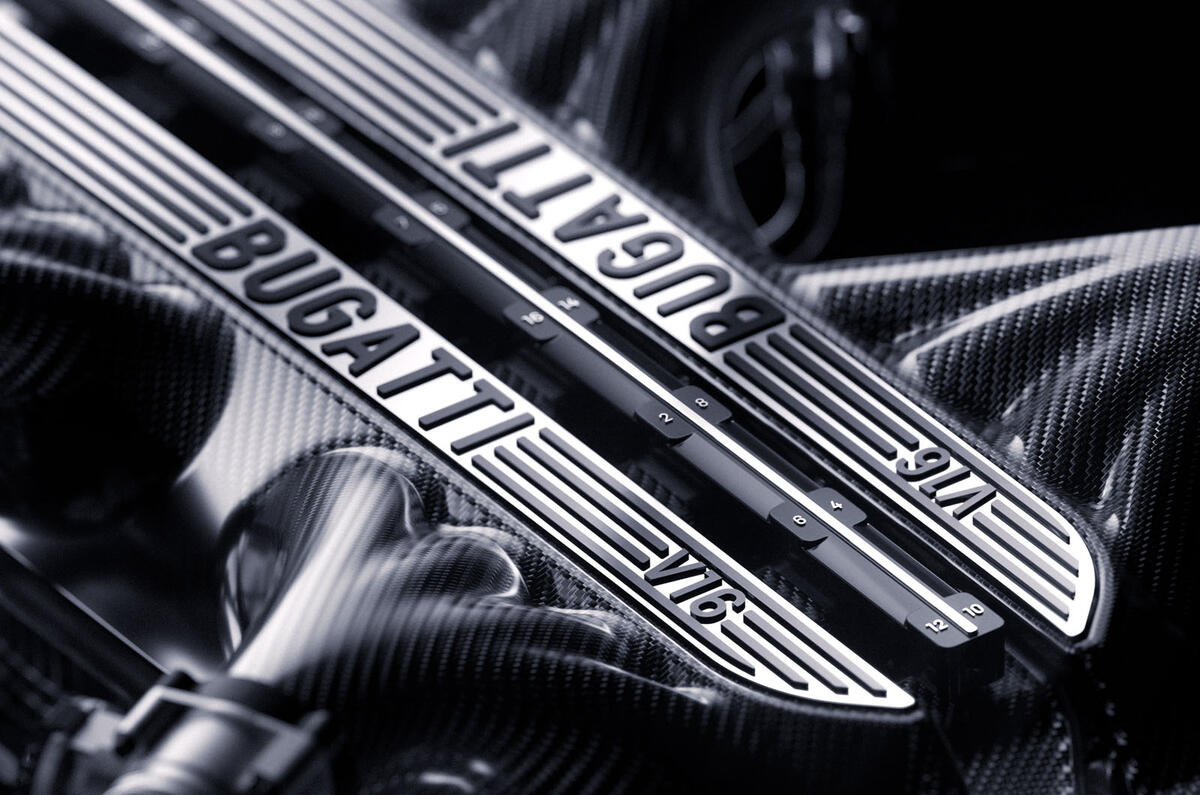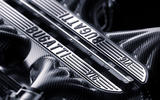Bugatti will launch its next hypercar, powered by a hybridised powertrain centered around a 1000bhp V16, on 20 June.
Announcing the date, the brand said its next-generation model will sport a “completely bespoke” design inspired by the iconic Type 57 SC Atlantic, Type 41 Royale and Type 35 models.
They “each lend their DNA to create a pure and authentic reinterpretation of the Bugatti brand”, it added.
Last week, the French hypercar maker brought its eight-year Chiron era to an end with the Super Sport L’Ultime, a special one-off. That final model also marks the end of the brand's famed W16 engine.
Bugatti recently revealed the shape and layout of the V16, as well as its screaming soundtrack (below), and CEO Mate Rimac gave extra details in an interview at the Financial Times Future of the Car conference in London.
Rimac revealed that the colossal engine goes without forced induction, unlike its W16 predecessor, which inhaled through four turbochargers.
The engine itself, he added, will measure a whopping one metre long in its own right – 400mm longer than the four-bank unit from the Chiron.
Not just for the present. ⁰Or even for the future.Pour l‘éternité.Embark on BUGATTI's new era.20.06.2024#BUGATTI #PourLÉternité pic.twitter.com/5ADVgGIP3v
— Bugatti (@Bugatti) June 4, 2024
Despite that (and the integration of a substantial electric drivetrain element), the car will be a similar shape to its predecessor, suggested Rimac. He said: "The exterior is an evolution. You can still see the very distinct Bugatti design."
Certainly, spy shots circulating the internet in recent weeks indicate that it will have a familiar silhouette but be somewhat lower and sleeker than the Chiron it replaces.
Rimac, despite being best known for his pioneering work creating electric hypercars and supplying battery tech to a number of global car manufacturers, said he was a driving force behind bringing the V16 to fruition.
He said "the business plan was to make an electric coupé-SUV type of thing" before his eponymous firm took over Bugatti from the Volkswagen Group.
"Management was saying the next car has to be electric," he added, acknowledging that a rebadged and restyled version of the Rimac Nevera would have theoretically made a logical electric replacement for the Chiron. But maintaining differentiation between the two hypercar brands, while honouring the heritage of Bugatti, was essential.
Rimac said: "You could very easily and convincingly make a Bugatti out of [the Nevera] – just make a different design and call it a day – but I thought that was absolutely wrong for the brand.
"Luckily, I won that argument three years ago when electrification was all the rage, which it isn't any more…" Rimac was referring to the perceived decline in demand for electric hypercars - acknowledging that his firm has still not sold all 150 Neveras.














Join the debate
Add your comment
I know there was the Royale - but Bugatti was best known for elegant engineering in light cars. Think Type 35 etc. These monsters are nothing to do with that legacy. Bugatti were the Colin Chapman Lotus of the 30s. Genuinely I'd rather have a Mark 1 Elise than a Chiron - although I might like to keep the change if it was offered.
I get the emotional side of this. However I'd love to see a company take something like a 3 cylinder engine and make that work in a supercar. It would be an engineering feat to produce huge amounts of power from the smallest number of cylinders possible. Maybe something more for Lotus than Bugatti.
One engine driving each Wheel?, you may correct me on this but, I've never read of a road three cylinder engine that produced a four figure HP, and yes it's heavy, it's never going to be Chapman light,it's not meant for chucking through tight bends on the door handles, it's a straight line hyper speed 300mph+ Continent shrinker, somebody must drive one every day,and, this is a one hurrah car, it's probably sold already for a seven maybe eight figure sum, let's admire it for what it stands for, the firsts it developed, gulp at the cost of Tyres, how quick it could drink petrol, these things don't matter to the owner, they are like us, they love to drive.
So if Rimac haven't sold all their electric hypercars yet, I'm assuming Lotus hasn't either. It was sheer folly on Lotus.
Does anyone know why my comments are rejected "due to Spam control rules?" It goes on about embedded links which I don't know how to use let only actually do so. Autocar really ought to do something about this site - it's like something from the early 90s.